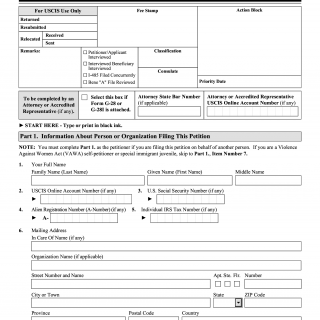Form I-360. Petition for Amerasian, Widow(er), or Special Immigrant
Form I-360, also known as the Petition for Amerasian, Widow(er), or Special Immigrant, is a crucial form for individuals seeking immigration benefits in the United States. This form serves as an application for special immigrant status based on various categories, including Amerasians, widows or widowers of U.S. citizens, and certain special immigrants.
When filling out Form I-360, it is essential to provide accurate and complete information to ensure a smooth application process. The form consists of several sections that require specific details:
- Part 1: Information About You (Petitioner) - This section collects personal information about the petitioner, such as their name, address, date of birth, and contact details.
- Part 2: Information About the Person You Are Petitioning For - In this section, the petitioner provides details about the beneficiary, including their relationship to the petitioner and their immigration status.
- Part 3: Basis for Petition - This part requires the petitioner to specify the category under which they are filing the petition, such as Amerasian, widow(er), or special immigrant.
- Part 4: Additional Information - Here, the petitioner can provide any additional relevant information to support their petition.
When completing Form I-360, it is crucial to have the following information at hand:
- Personal information for both the petitioner and the beneficiary, including full names, addresses, dates of birth, and contact details.
- Relevant documentation to establish eligibility, such as proof of relationship, marriage certificates, death certificates, or evidence of Amerasian ancestry.
It is important to note that Form I-360 requires supporting documentation to substantiate the claims made in the petition. The specific documents required may vary depending on the category under which the petition is filed. These supporting documents may include:
- Proof of Amerasian ancestry
- Evidence of the petitioner's relationship to the beneficiary
- Proof of the petitioner's status as a widow(er) of a U.S. citizen
- Documentation establishing eligibility as a special immigrant
Application examples and use cases for Form I-360 include:
- Amerasian individuals seeking immigration benefits based on their parentage from a U.S. citizen.
- Widows or widowers of U.S. citizens who wish to obtain immigration benefits.
- Special immigrants, such as religious workers, employees of international organizations, or certain Afghan or Iraqi nationals who have worked for the U.S. government.
It's important to note that there are no direct alternatives or analogues to Form I-360. However, it is related to other immigration forms, such as Form I-485 (Application to Register Permanent Residence or Adjust Status), which is typically filed concurrently with Form I-360 for certain categories.
Once completed, Form I-360 can be submitted by mail to the appropriate address provided by the United States Citizenship and Immigration Services (USCIS). It is essential to retain a copy of the form and all supporting documents for your records. The USCIS will review the form and make a decision on the eligibility of the petitioner for the requested immigration benefits.

